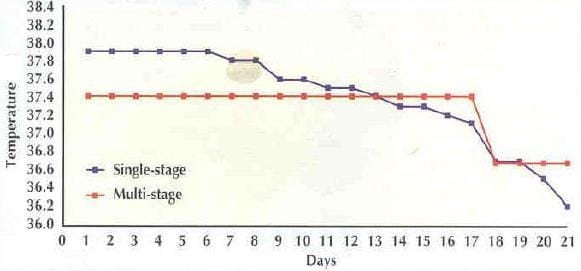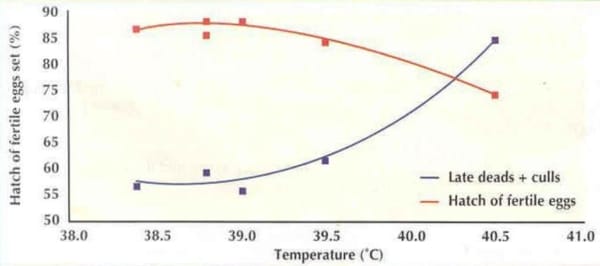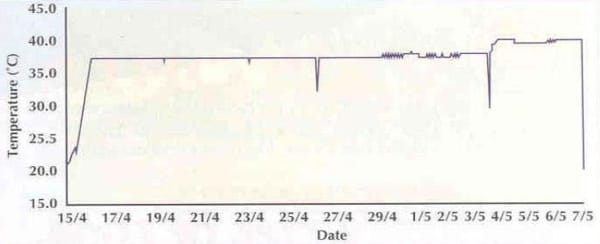...
--> Three key areas
--> Hatchability and temperature
--> Stimulation of yolk transfer
...
INCUBATION CONDITIONS AND BROILER PERFORMANCE
By A.D. Nicholson, Aviagen Ltd, Newbridge, Midiothian EH28 8SZ, Scotland
.
The overall performance of a hatchery is generally assessed on the basis of hatchability, first week broiler mortality and, occasionally, culling rates. Its is difficult to assess chick quality at the hatchery, so as long as hatchability and early chick liveability fall within acceptable bands, the hatchery is usually considered to be achieving all that can reasonably be expected of it.
However, the 21 days that the chick spends in the incubator is significant proportion of its life; for a broiler killed at 40 days, 34 % of its total life span is spent in the egg. Recent research has shown that aspects of incubation and hatchery process control can have profound effects on broiler performance all the way up to slaughter weights. Often, small changes will generate significant improvements.
THREE KEY AREAS
There are three main areas to consider: embryo temperature after 15 days, the amount of time the eggs spend in the incubator, and the interval between hatching and when the chick is first fed.
During incubation chicken embryos develop from the germinal disc found in the fertile egg at oviposition into fully functional, live chicks. To do this, they need to experience a consistent temperature. Heat has to be supplied from outside the egg for roughly the first half of incubation. Then, the embryo starts to generate heat and, after about 15 days of incubation, metabolic heat production increases to a point where heat removal from the mass of eggs becomes essential.
It is important at this point to distinguish between the temperature of the air within an incubator and the temperature inside the egg itself. It is largely this distinction that leads to temperature recommendations for different makes and types of incubator varying quite widely, while producing approximately similar end results. An embryo temperature of between 37 and 38oC (98.6 – 100.4oF) will usually give acceptable results.
To achieve a constant embryo temperature over 21 days, the temperature of the surrounding air will need to decrease steadily throughout incubation. In multi-stage machines, this is achieved by setting patterns where cold eggs are placed next to those generating the most heat.
Figure 1 A change in the temperature of the types of incubator
In single-stage machines, the temperature settings will need to be raised at the beginning of incubation and dropped later on, as shown in Fig.1, which illustrates a sample temperature profile developed for use in Aviagen’s single stage parent stock hatcheries in the UK; for broiler eggs, which are more fertile and so generate more heat, a similar process would need to be followed to develop a suitable profile.
Observations of high shell surface or embryo temperatures towards the end of incubation have been reported by research workers in both Europe and the USA. When these are seen, it is usually because the eggs in the incubators are generating more heat than the machine is able to handle. Usually, high temperatures occur at predictable positions within the machine, at points where air-flow and cooling are marginal – they are not commonly a problem throughout the incubator.
.
CAUSES OF HOT SPOTS
A commercial incubator is basically an insulated box, with the means to heat and cool the air within it, while fans bring fresh air into the machine and also distribute air throughout the mass of eggs. Multistage incubators rely on having eggs at a range of developmental stages in the machine to keep the temperature even, while in a single-stage machine all the eggs will have been set at the same time, so the machine has to work much harder to maintain consistent, even conditions throughout the whole incubation period.
Hot spots can be due to any of several factors:
- Older or poorly maintained machines may struggle do cope with a full load of fertile eggs.
- Machines may have been modified to take more eggs without upgrading cooling and ventilation, thus overloading the cooling and ventilation system.
- Fixed rack multi-stage machines have had the curtains removed without upgrading the fans to cope with the altered air flow patterns.
- Insufficient attention may have been paid to airflow in the design of single-stage machines.
- A drive to control energy costs to the hatchery may limit fan capacity and usage.
- Unbalanced loading in multi-stage machines.
- Large differences in flock age (and therefore hatch potential and so heat production) in single-stage machines.
Research by Sander Lourens at Spelderholt and Lelystadt has shown a clear relationship between hatchability and egg surface temperature at 432 hours (18 days) of incubation in a commercial hatchery. This is shown in Fig. 2
Figure 2 Relationship between hatchability and egg surface temperature
^ Top page
.
HATCHABILITY AND TEMPERATURE
Hatchability was lower when ever the egg surface temperature exceeded 39oC, and was reduced by 15% when the surface temperature reached 40.5oC.
The observations were then duplicated in a trial incubator, this time altering the incubator.
Temperature settings on a dynamic basis so as either to achieve shell surface temperatures of a constant 37.8oC, or shell temperatures rising from 37.5oC at set, to 38.6oC from 12 days of incubation onwards. Although the rising temperature was in the range where no damage was done in the commercial incubator, in this experiment the rising temperature treatment was associated with a 4 – 5 % drop in hatch of fertile eggs, and chick weights that were 2.9g lower than the constant temperature treatment.
However, the chicks were then grown on, and it was found that the rising temperature regimen was also associated with poorer grow out performance. At 41 days, as hatched weights were 40g lower and feed conversion five points worse for the heat stressed embryos than those incubated under constant temperature.
At much the same time, investigations in the USA were focusing on problems of gut health and immune competence in broiler flocks which allowed them to overheat in the hatcher. The temperatures amongst the eggs (not egg surface temperature) were reaching around 40oC.
Fig.3 shows a typical temperature profile, where the temperature surrounding the eggs was over 40oC for most of the time the eggs spent in the hatcher. In an attempt to assess what damage may be done by higher incubation temperatures, tissues from chicks with either heat stressed or non – stressed incubation histories were subjected to histological analysis. The tissues examined were from the gut (duodenum, jejunum, ileum/ caecum), the bursa and the liver.
Figure 3 Typical temperature profile when the temperature surrounding the eggs was over 40oC
There were no differences in the liver samples. The bursal samples were not particularly conclusive, but did suggest that the immune system of the heat stressed embryos seemed more immature. However, the gut samples showed a clear advantage to the non-stressed embryos, which had significantly greater potential for epithelium generation and regeneration.
These observations do offer some basis for understanding the field observations that chicks which have been heat stressed in the incubator are more prone to problems with immunosuppressive and enteric diseases.
Moving on to the issue of chick emergence patterns, the observation that the Ross chicks are tending to need less time in the incubators than they used to is becoming increasingly common worldwide. This is not in any way a problem, provided that adjustments are made so that chicks are at an appropriate stage of development when they are removed from the hatcher.
A quick and simple way to assess whether incubation times are optimal is to weigh the eggs just before they are set and the chicks immediately after they are removed from the hatcher. If average chick weight is between 66 and 68% of average egg weight, then there are no major problems. The yield of chicks is also important, a chick yield of 64% indicating that the eggs are spending 4 – 6 hours longer in the incubator than they really need to. The chicks may dehydrate during this time and feeding will be delayed. Conversely, with a chick yield of 69 %, the chicks will be extremely difficult to feather sex.
The amount of time eggs need in the incubator will be driven to some extent by egg size; large eggs take longer to reach incubation temperatures. Any significant movement in egg size due to nutritional or other charges should always trigger a check on incubation chick yields.
Research at the Hebrew University in Israel by Yael Noy and others has focused on the changes that take place immediately after hatching, as the hatchling converts from obtaining all its nutrients directly from egg yolk to obtaining all its nutrients from ingested feed. The changeover normally takes 2 – 3 days, but can be speeded up if the chick is fed within six hours of its clearing the egg shell on hatching.
^ Top page
.
STIMULATION OF YOLK TRANSFER
The timely presence of feed in the gut stimulates the transfer of egg yolk into the gut, facilitates optimal development of the absorptive surface of the gut, increases the number of muscle precursor cells and as a result can improve both live weight and breast meat yield at normal slaughter ages by 5 – 10%. It follows that if embryos are being heat stressed during incubation, or hatching earlier than expected, then they are unlikely to be fed as soon as is really desirable, so gut development and grow out performance may both be adversely affected.
The research in Israel has focused on very early feeding. However, trials carried out within Aviagen’s UK and US hatcheries have looked at the impact of giving a hatchling supplement in the chick boxes after the chicks have been processed but before they are transported to their final destination. Various parameters were recorded, but one of the most consistent effects was a 4 – 5% increase in seven day body weight where the supplement had been given.
Good management on the broiler farm remains vital for good broiler performance; when the hatchery observes all the points above, the very best performance should be achievable.
^ Top page
If you need to download this article, please do not hesitate to contact us!

 Corporate Website
Corporate Website
 Africa
Africa
 Argentina
Argentina
 Asia
Asia
 Australia
Australia
 Belgium
Belgium
 Brazil
Brazil
 Bulgaria
Bulgaria
 Canada (EN)
Canada (EN)
 Chile
Chile
 China
China
 Colombia
Colombia
 Denmark
Denmark
 Egypt
Egypt
 France
France
 Germany
Germany
 Greece
Greece
 Hungary
Hungary
 Indonesia
Indonesia
 Italia
Italia
 India
India
 Japan
Japan
 Korea
Korea
 Malaysia
Malaysia
 Mexico
Mexico
 Middle East
Middle East
 Netherlands
Netherlands
 Peru
Peru
 Philippines
Philippines
 Poland
Poland
 Portugal
Portugal
 Romania
Romania
 Russia
Russia
 South Africa
South Africa
 Spain
Spain
 Sweden
Sweden
 Thailand
Thailand
 Tunisia
Tunisia
 Turkey
Turkey
 Ukraine
Ukraine
 United Kingdom
United Kingdom
 USA
USA
 Vietnam
Vietnam







